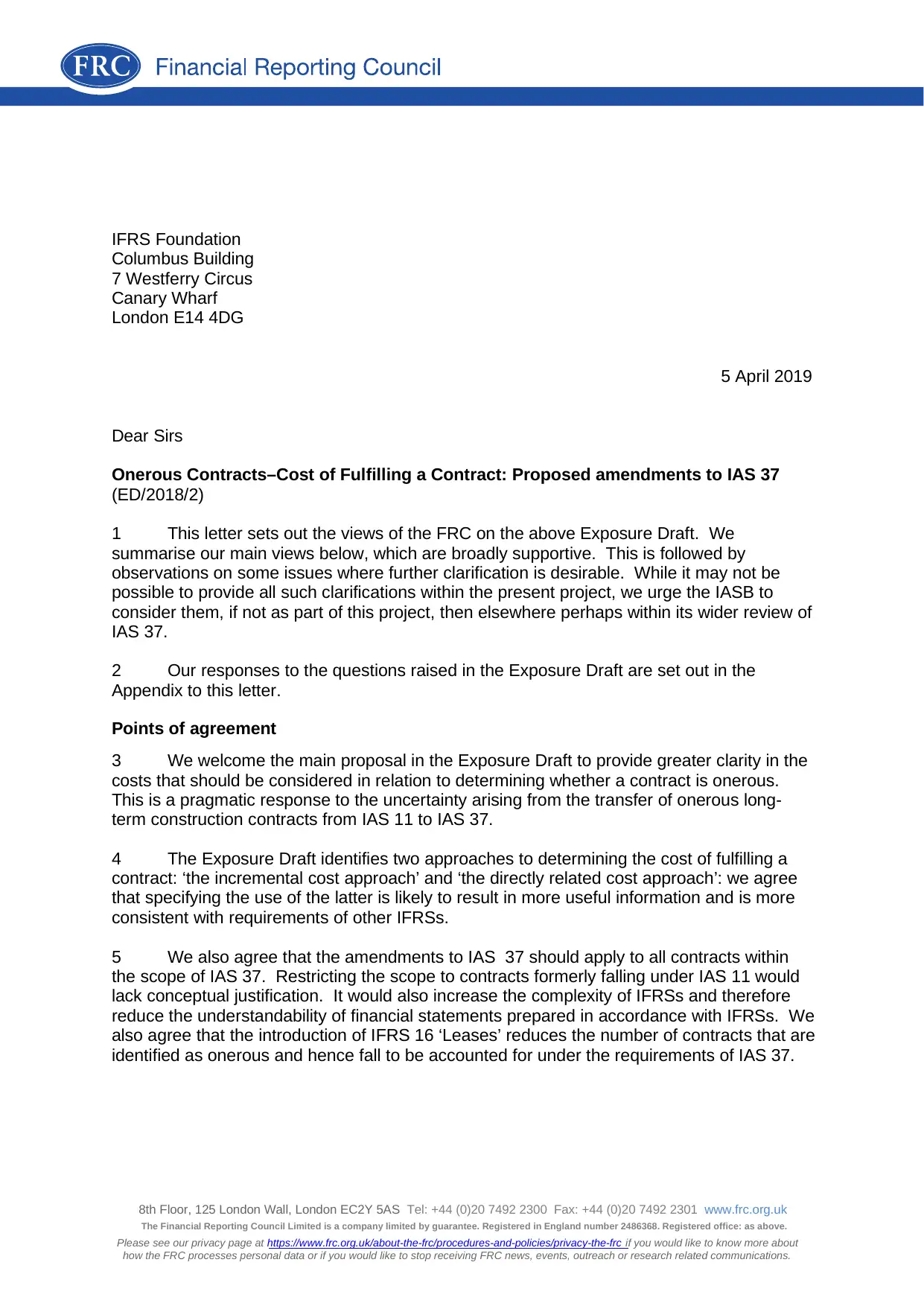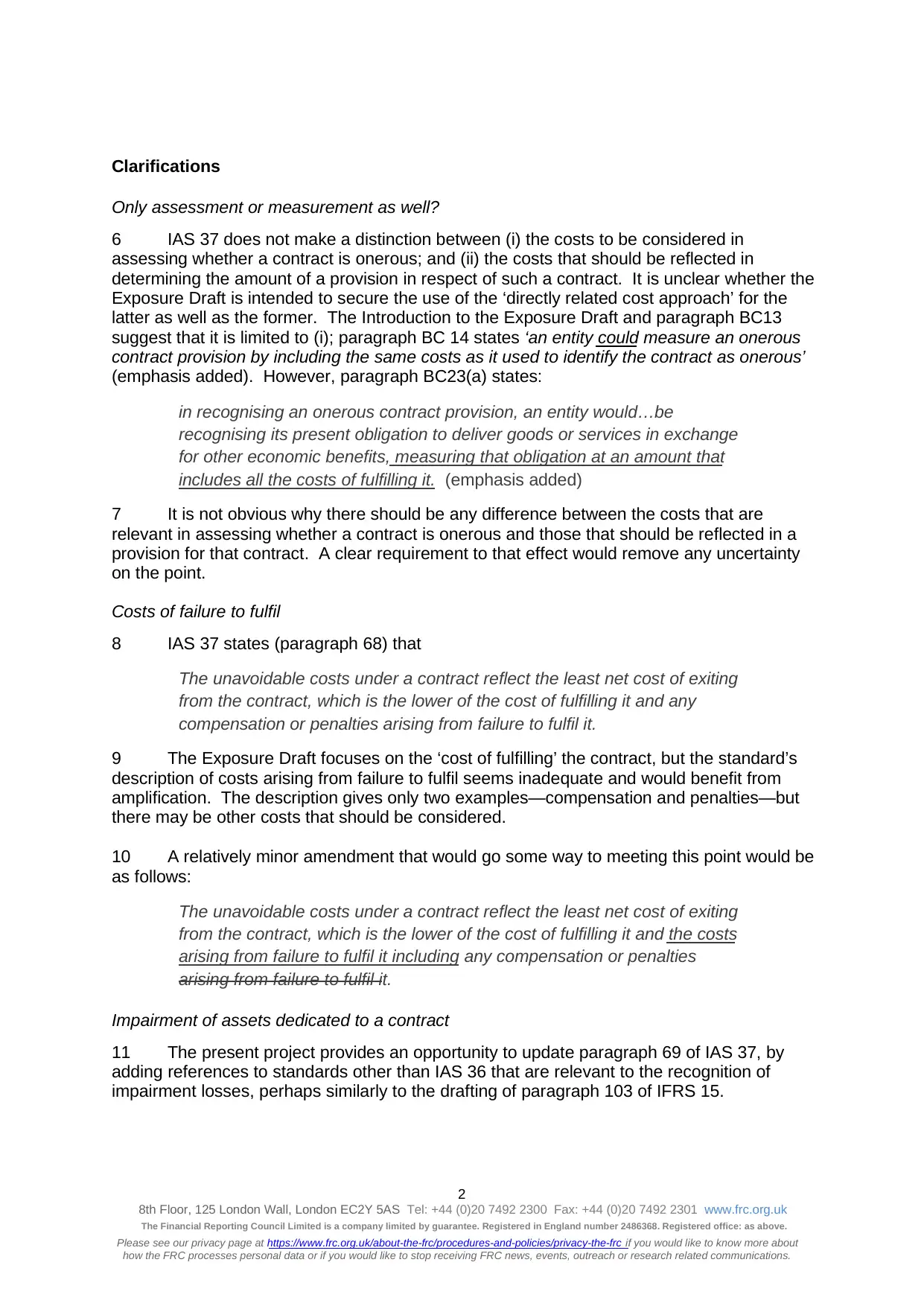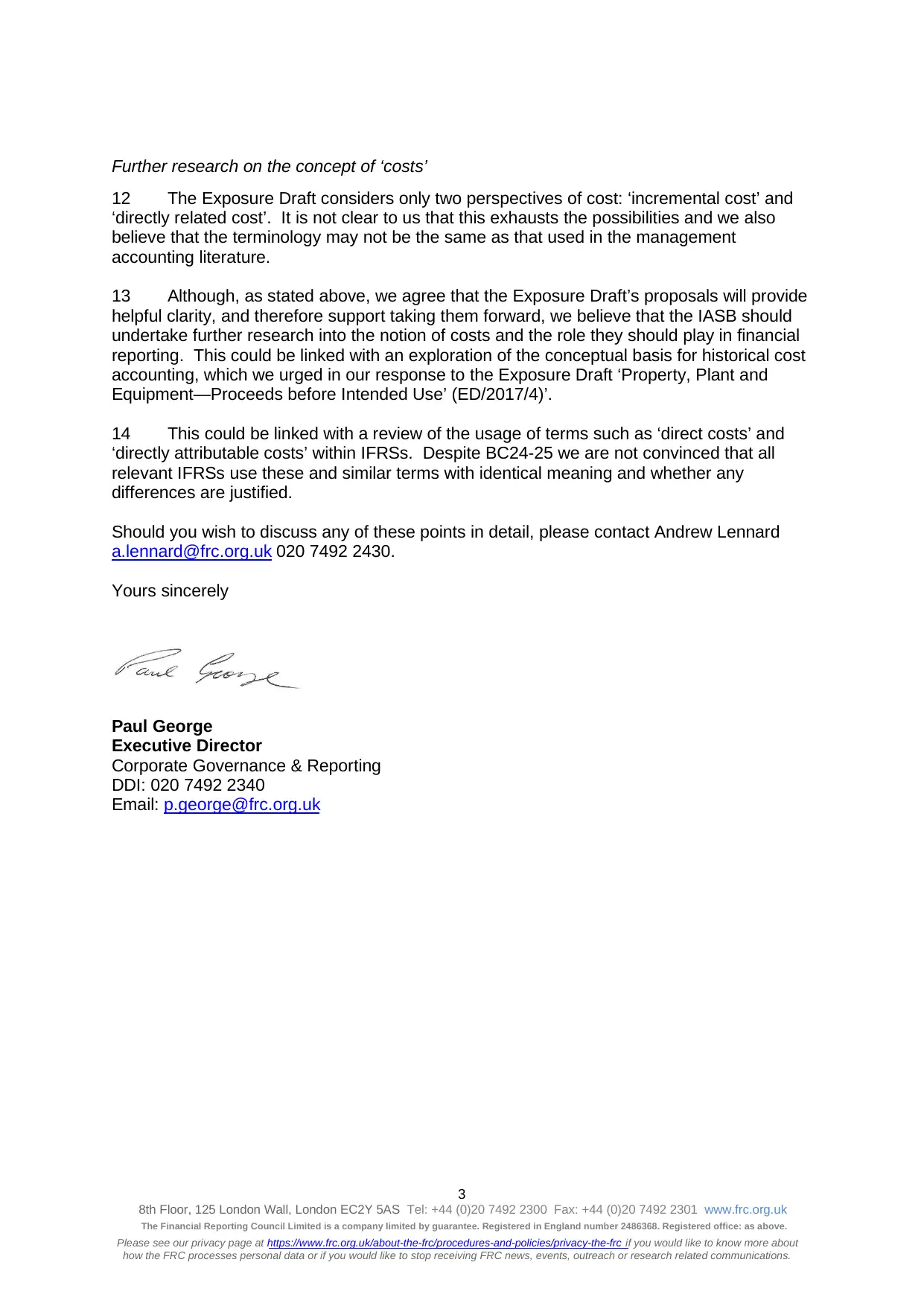FRC's Response and Analysis of IFRS 37 Onerous Contracts Amendments
VerifiedAdded on 2023/03/17
|3
|1359
|31
Report
AI Summary
This document presents the Financial Reporting Council's (FRC) response to the IFRS Foundation's Exposure Draft on 'Onerous Contracts – Cost of Fulfilling a Contract,' proposing amendments to IAS 37. The FRC broadly supports the proposals, which aim to clarify the costs considered in determining whether a contract is onerous, favoring the 'directly related cost approach.' The response highlights points of agreement, such as the scope of the amendments applying to all contracts under IAS 37. It also provides clarifications on the application of the 'directly related cost approach' for assessing and measuring onerous contracts and suggests an amplification of the description of costs arising from failure to fulfill a contract. Furthermore, the FRC suggests updating paragraph 69 of IAS 37 and recommends further research into the concept of 'costs' within financial reporting, including the terminology used. The document concludes with a contact for further discussion and is a valuable resource for understanding the FRC's perspective on these important accounting standards.

8th Floor, 125 London Wall, London EC2Y 5AS Tel: +44 (0)20 7492 2300 Fax: +44 (0)20 7492 2301 www.frc.org.uk
The Financial Reporting Council Limited is a company limited by guarantee. Registered in England number 2486368. Registered office: as above.
Please see our privacy page at https://www.frc.org.uk/about-the-frc/procedures-and-policies/privacy-the-frc if you would like to know more about
how the FRC processes personal data or if you would like to stop receiving FRC news, events, outreach or research related communications.
IFRS Foundation
Columbus Building
7 Westferry Circus
Canary Wharf
London E14 4DG
5 April 2019
Dear Sirs
Onerous Contracts–Cost of Fulfilling a Contract: Proposed amendments to IAS 37
(ED/2018/2)
1 This letter sets out the views of the FRC on the above Exposure Draft. We
summarise our main views below, which are broadly supportive. This is followed by
observations on some issues where further clarification is desirable. While it may not be
possible to provide all such clarifications within the present project, we urge the IASB to
consider them, if not as part of this project, then elsewhere perhaps within its wider review of
IAS 37.
2 Our responses to the questions raised in the Exposure Draft are set out in the
Appendix to this letter.
Points of agreement
3 We welcome the main proposal in the Exposure Draft to provide greater clarity in the
costs that should be considered in relation to determining whether a contract is onerous.
This is a pragmatic response to the uncertainty arising from the transfer of onerous long-
term construction contracts from IAS 11 to IAS 37.
4 The Exposure Draft identifies two approaches to determining the cost of fulfilling a
contract: ‘the incremental cost approach’ and ‘the directly related cost approach’: we agree
that specifying the use of the latter is likely to result in more useful information and is more
consistent with requirements of other IFRSs.
5 We also agree that the amendments to IAS 37 should apply to all contracts within
the scope of IAS 37. Restricting the scope to contracts formerly falling under IAS 11 would
lack conceptual justification. It would also increase the complexity of IFRSs and therefore
reduce the understandability of financial statements prepared in accordance with IFRSs. We
also agree that the introduction of IFRS 16 ‘Leases’ reduces the number of contracts that are
identified as onerous and hence fall to be accounted for under the requirements of IAS 37.
The Financial Reporting Council Limited is a company limited by guarantee. Registered in England number 2486368. Registered office: as above.
Please see our privacy page at https://www.frc.org.uk/about-the-frc/procedures-and-policies/privacy-the-frc if you would like to know more about
how the FRC processes personal data or if you would like to stop receiving FRC news, events, outreach or research related communications.
IFRS Foundation
Columbus Building
7 Westferry Circus
Canary Wharf
London E14 4DG
5 April 2019
Dear Sirs
Onerous Contracts–Cost of Fulfilling a Contract: Proposed amendments to IAS 37
(ED/2018/2)
1 This letter sets out the views of the FRC on the above Exposure Draft. We
summarise our main views below, which are broadly supportive. This is followed by
observations on some issues where further clarification is desirable. While it may not be
possible to provide all such clarifications within the present project, we urge the IASB to
consider them, if not as part of this project, then elsewhere perhaps within its wider review of
IAS 37.
2 Our responses to the questions raised in the Exposure Draft are set out in the
Appendix to this letter.
Points of agreement
3 We welcome the main proposal in the Exposure Draft to provide greater clarity in the
costs that should be considered in relation to determining whether a contract is onerous.
This is a pragmatic response to the uncertainty arising from the transfer of onerous long-
term construction contracts from IAS 11 to IAS 37.
4 The Exposure Draft identifies two approaches to determining the cost of fulfilling a
contract: ‘the incremental cost approach’ and ‘the directly related cost approach’: we agree
that specifying the use of the latter is likely to result in more useful information and is more
consistent with requirements of other IFRSs.
5 We also agree that the amendments to IAS 37 should apply to all contracts within
the scope of IAS 37. Restricting the scope to contracts formerly falling under IAS 11 would
lack conceptual justification. It would also increase the complexity of IFRSs and therefore
reduce the understandability of financial statements prepared in accordance with IFRSs. We
also agree that the introduction of IFRS 16 ‘Leases’ reduces the number of contracts that are
identified as onerous and hence fall to be accounted for under the requirements of IAS 37.
Paraphrase This Document
Need a fresh take? Get an instant paraphrase of this document with our AI Paraphraser

2
8th Floor, 125 London Wall, London EC2Y 5AS Tel: +44 (0)20 7492 2300 Fax: +44 (0)20 7492 2301 www.frc.org.uk
The Financial Reporting Council Limited is a company limited by guarantee. Registered in England number 2486368. Registered office: as above.
Please see our privacy page at https://www.frc.org.uk/about-the-frc/procedures-and-policies/privacy-the-frc if you would like to know more about
how the FRC processes personal data or if you would like to stop receiving FRC news, events, outreach or research related communications.
Clarifications
Only assessment or measurement as well?
6 IAS 37 does not make a distinction between (i) the costs to be considered in
assessing whether a contract is onerous; and (ii) the costs that should be reflected in
determining the amount of a provision in respect of such a contract. It is unclear whether the
Exposure Draft is intended to secure the use of the ‘directly related cost approach’ for the
latter as well as the former. The Introduction to the Exposure Draft and paragraph BC13
suggest that it is limited to (i); paragraph BC 14 states ‘an entity could measure an onerous
contract provision by including the same costs as it used to identify the contract as onerous’
(emphasis added). However, paragraph BC23(a) states:
in recognising an onerous contract provision, an entity would…be
recognising its present obligation to deliver goods or services in exchange
for other economic benefits, measuring that obligation at an amount that
includes all the costs of fulfilling it. (emphasis added)
7 It is not obvious why there should be any difference between the costs that are
relevant in assessing whether a contract is onerous and those that should be reflected in a
provision for that contract. A clear requirement to that effect would remove any uncertainty
on the point.
Costs of failure to fulfil
8 IAS 37 states (paragraph 68) that
The unavoidable costs under a contract reflect the least net cost of exiting
from the contract, which is the lower of the cost of fulfilling it and any
compensation or penalties arising from failure to fulfil it.
9 The Exposure Draft focuses on the ‘cost of fulfilling’ the contract, but the standard’s
description of costs arising from failure to fulfil seems inadequate and would benefit from
amplification. The description gives only two examples—compensation and penalties—but
there may be other costs that should be considered.
10 A relatively minor amendment that would go some way to meeting this point would be
as follows:
The unavoidable costs under a contract reflect the least net cost of exiting
from the contract, which is the lower of the cost of fulfilling it and the costs
arising from failure to fulfil it including any compensation or penalties
arising from failure to fulfil it.
Impairment of assets dedicated to a contract
11 The present project provides an opportunity to update paragraph 69 of IAS 37, by
adding references to standards other than IAS 36 that are relevant to the recognition of
impairment losses, perhaps similarly to the drafting of paragraph 103 of IFRS 15.
8th Floor, 125 London Wall, London EC2Y 5AS Tel: +44 (0)20 7492 2300 Fax: +44 (0)20 7492 2301 www.frc.org.uk
The Financial Reporting Council Limited is a company limited by guarantee. Registered in England number 2486368. Registered office: as above.
Please see our privacy page at https://www.frc.org.uk/about-the-frc/procedures-and-policies/privacy-the-frc if you would like to know more about
how the FRC processes personal data or if you would like to stop receiving FRC news, events, outreach or research related communications.
Clarifications
Only assessment or measurement as well?
6 IAS 37 does not make a distinction between (i) the costs to be considered in
assessing whether a contract is onerous; and (ii) the costs that should be reflected in
determining the amount of a provision in respect of such a contract. It is unclear whether the
Exposure Draft is intended to secure the use of the ‘directly related cost approach’ for the
latter as well as the former. The Introduction to the Exposure Draft and paragraph BC13
suggest that it is limited to (i); paragraph BC 14 states ‘an entity could measure an onerous
contract provision by including the same costs as it used to identify the contract as onerous’
(emphasis added). However, paragraph BC23(a) states:
in recognising an onerous contract provision, an entity would…be
recognising its present obligation to deliver goods or services in exchange
for other economic benefits, measuring that obligation at an amount that
includes all the costs of fulfilling it. (emphasis added)
7 It is not obvious why there should be any difference between the costs that are
relevant in assessing whether a contract is onerous and those that should be reflected in a
provision for that contract. A clear requirement to that effect would remove any uncertainty
on the point.
Costs of failure to fulfil
8 IAS 37 states (paragraph 68) that
The unavoidable costs under a contract reflect the least net cost of exiting
from the contract, which is the lower of the cost of fulfilling it and any
compensation or penalties arising from failure to fulfil it.
9 The Exposure Draft focuses on the ‘cost of fulfilling’ the contract, but the standard’s
description of costs arising from failure to fulfil seems inadequate and would benefit from
amplification. The description gives only two examples—compensation and penalties—but
there may be other costs that should be considered.
10 A relatively minor amendment that would go some way to meeting this point would be
as follows:
The unavoidable costs under a contract reflect the least net cost of exiting
from the contract, which is the lower of the cost of fulfilling it and the costs
arising from failure to fulfil it including any compensation or penalties
arising from failure to fulfil it.
Impairment of assets dedicated to a contract
11 The present project provides an opportunity to update paragraph 69 of IAS 37, by
adding references to standards other than IAS 36 that are relevant to the recognition of
impairment losses, perhaps similarly to the drafting of paragraph 103 of IFRS 15.

3
8th Floor, 125 London Wall, London EC2Y 5AS Tel: +44 (0)20 7492 2300 Fax: +44 (0)20 7492 2301 www.frc.org.uk
The Financial Reporting Council Limited is a company limited by guarantee. Registered in England number 2486368. Registered office: as above.
Please see our privacy page at https://www.frc.org.uk/about-the-frc/procedures-and-policies/privacy-the-frc if you would like to know more about
how the FRC processes personal data or if you would like to stop receiving FRC news, events, outreach or research related communications.
Further research on the concept of ‘costs’
12 The Exposure Draft considers only two perspectives of cost: ‘incremental cost’ and
‘directly related cost’. It is not clear to us that this exhausts the possibilities and we also
believe that the terminology may not be the same as that used in the management
accounting literature.
13 Although, as stated above, we agree that the Exposure Draft’s proposals will provide
helpful clarity, and therefore support taking them forward, we believe that the IASB should
undertake further research into the notion of costs and the role they should play in financial
reporting. This could be linked with an exploration of the conceptual basis for historical cost
accounting, which we urged in our response to the Exposure Draft ‘Property, Plant and
Equipment—Proceeds before Intended Use’ (ED/2017/4)’.
14 This could be linked with a review of the usage of terms such as ‘direct costs’ and
‘directly attributable costs’ within IFRSs. Despite BC24-25 we are not convinced that all
relevant IFRSs use these and similar terms with identical meaning and whether any
differences are justified.
Should you wish to discuss any of these points in detail, please contact Andrew Lennard
a.lennard@frc.org.uk 020 7492 2430.
Yours sincerely
Paul George
Executive Director
Corporate Governance & Reporting
DDI: 020 7492 2340
Email: p.george@frc.org.uk
8th Floor, 125 London Wall, London EC2Y 5AS Tel: +44 (0)20 7492 2300 Fax: +44 (0)20 7492 2301 www.frc.org.uk
The Financial Reporting Council Limited is a company limited by guarantee. Registered in England number 2486368. Registered office: as above.
Please see our privacy page at https://www.frc.org.uk/about-the-frc/procedures-and-policies/privacy-the-frc if you would like to know more about
how the FRC processes personal data or if you would like to stop receiving FRC news, events, outreach or research related communications.
Further research on the concept of ‘costs’
12 The Exposure Draft considers only two perspectives of cost: ‘incremental cost’ and
‘directly related cost’. It is not clear to us that this exhausts the possibilities and we also
believe that the terminology may not be the same as that used in the management
accounting literature.
13 Although, as stated above, we agree that the Exposure Draft’s proposals will provide
helpful clarity, and therefore support taking them forward, we believe that the IASB should
undertake further research into the notion of costs and the role they should play in financial
reporting. This could be linked with an exploration of the conceptual basis for historical cost
accounting, which we urged in our response to the Exposure Draft ‘Property, Plant and
Equipment—Proceeds before Intended Use’ (ED/2017/4)’.
14 This could be linked with a review of the usage of terms such as ‘direct costs’ and
‘directly attributable costs’ within IFRSs. Despite BC24-25 we are not convinced that all
relevant IFRSs use these and similar terms with identical meaning and whether any
differences are justified.
Should you wish to discuss any of these points in detail, please contact Andrew Lennard
a.lennard@frc.org.uk 020 7492 2430.
Yours sincerely
Paul George
Executive Director
Corporate Governance & Reporting
DDI: 020 7492 2340
Email: p.george@frc.org.uk
⊘ This is a preview!⊘
Do you want full access?
Subscribe today to unlock all pages.

Trusted by 1+ million students worldwide
1 out of 3
Related Documents
Your All-in-One AI-Powered Toolkit for Academic Success.
+13062052269
info@desklib.com
Available 24*7 on WhatsApp / Email
![[object Object]](/_next/static/media/star-bottom.7253800d.svg)
Unlock your academic potential
Copyright © 2020–2025 A2Z Services. All Rights Reserved. Developed and managed by ZUCOL.





